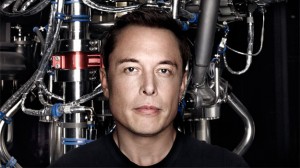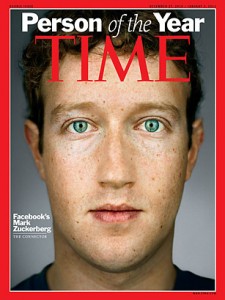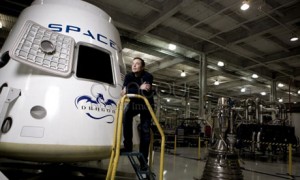 Over at TESLA/SpaceX, the power of dynamic, aggressively public leadership is on full display. Elon Musk gets in front of the cameras, engages blogs and even plays in the twittersphere—relishing his role as publicist-in-chief. His name and his hip image are irrevocably melded to his businesses—which are now recognized across the globe.
Over at TESLA/SpaceX, the power of dynamic, aggressively public leadership is on full display. Elon Musk gets in front of the cameras, engages blogs and even plays in the twittersphere—relishing his role as publicist-in-chief. His name and his hip image are irrevocably melded to his businesses—which are now recognized across the globe.
In comparison, CEOs in the “Big Defense” companies spend far less time tending their public personas, and seem content to be seen as colorless, faceless and largely anonymous outside their company’s immediate sphere of influence—despite the fact that their personal stories, technical competency and value to the nation may, in some instances, outstrip Mr. Musk.
I mean, many readers of this blog would likely fail to recognize Marillyn Hewson (President and CEO of Lockheed) or Linda Hudson (President and CEO of BAE Systems) or Phebe Novakovic (CEO General Dynamics) in a DC Starbucks, while the very same readers would immediately swoon over Silicon Valley tycoons like Mark Zuckerberg, Marissa Mayer, Tim Cook or even Meg Whitman.
 Let me put it another way–take a second to compare these google.com image collections of Big Defense CEOs with this non-defense CEO. Or this one. Or this. (Please note that these images were collected on 1 January 2014–one hopes they’re being updated rather quickly!)
Let me put it another way–take a second to compare these google.com image collections of Big Defense CEOs with this non-defense CEO. Or this one. Or this. (Please note that these images were collected on 1 January 2014–one hopes they’re being updated rather quickly!)
So…Which image collections are more compelling in a marketing sense?
And…which Company CEOs are pictured with their products or company logo?
Which ones aren’t?
It’s strange that the public image of the Big Defense CEOs seem–at least according to google’s image selection analytics–far too stodgy. Too stuck in the ‘90s. And it’s that sector-wide disconnect with today’s innovative business culture–a overtly populist edge–gives Mr. Musk and his other Silicon Valley confederates an opportunity to diminish their defense rivals. They’re taking full advantage–and it is one of the reasons why they–and not representatives of Big Defense companies–are being hailed as the champions of America’s technological future.
These tech populists have piqued America’s imagination, creativity and interest.
For the health of Big Defense, that’s gotta change.
What does Silicon Valley offer that Big Defense does not? I mean, it isn’t that high-flying Silicon Valley consumer-tech companies offer an enormous amount of truly earth-shattering technology (yet)—the tech behind Big Defense companies–BAE, Lockheed, Northrop Grumman, Boeing and General Dynamics–goes far beyond much of what is produced at Facebook. It’s not just that they are enjoying the interest of captured consumers (the number of folks who use a TESLA product pale in comparison veterans who work (or have worked) with Big Defense products.
It’s just that these Silicon Valley CEOs have (for better or worse) become the public embodiment of their companies and public representations of their particular fields of endeavor. Far too few Big Defense CEOs seem eager to show the public or otherwise highlight the qualities and skills that got them their massively important posts.
It’s enough to make grand ‘ole defense marketers like the Krupp family or Howard Hughes and Henry Kaiser shake their heads in frustration.
 It is undeniable that Silicon Valley is reaping the benefits of Big Defense’s shy and retiring public demeanor. Today, these hungry Silicon upstarts are driving the image of American tech-and the national tech agenda–forward. Big Defense CEOs just don’t move the business celebrity meter anymore, and risk forfeiting the advantages that usually come with such status.
It is undeniable that Silicon Valley is reaping the benefits of Big Defense’s shy and retiring public demeanor. Today, these hungry Silicon upstarts are driving the image of American tech-and the national tech agenda–forward. Big Defense CEOs just don’t move the business celebrity meter anymore, and risk forfeiting the advantages that usually come with such status.
And that is a mistake.
Look. Elevating a Big Defense CEO to Marketer-in-Chief is an easy and cost-effective means to quickly add enormous value and “buzz”. And–as a “new generation” of leaders begin taking the helm at many of the Big Defense companies–it’s important to remind these new leaders that leveraging their personality and image for the benefit of your company is easier now than ever before. Here’s why:
First, the environment is right. The American public adores high-profile CEOs. With the political leadership trapped by division, the public is starved for dynamic leadership. They have–I think–turned to high-profile CEOs out there (Warren Buffett, Steve Jobs, Bill Gates, etc.) to fill the vacuum.
Also, the Defense Media/Defense Business Media ecosystem required to build public “buzz” around Big Defense CEOs is maturing and, as these news outlets grow, they’ll need a constant stream of high-profile content more than they ever have before.
Those outlets able to boost a Big Defense CEO into the business/defense business mainstream—CNBC, Fox Business, Bloomberg, defenseone.com, businessinsider.com etc….are well-established and easy to engage. And there’s little risk–it’s all a chummy “scratch my back and we’ll scratch yours” environment between CEOs and the media outlets that depend upon them.
Second, the American public loves to transform companies into personalities. It is no secret that the average taxpayer will spend more time reading biographies than they ever will commit to examining a company prospectus.
That’s why Big Defense CEOs should put energy into crafting their public image. Any rags-to-riches story, a “scrappy winner” theme or spy story associated with a Big Defense CEO will be assimilated by the public far more quickly than a technical product portfolio—but once the public starts getting engaged in the CEO’s personal story, they’ll inevitably learn more about (and sympathize with) the wider company and their products, too.
It’s simple…sell America on Marillyn Hewson, and Lockheed will have gone a long way towards securing sales of Lockheed’s major product lines. Same rules apply for General Dynamics, BAE and all the other Big Defense conglomerates.
Third, the market focus is changing. Rather than focus on selling to the American government (let the corporate underlings do that), the CEOs need to get out there and sell their vision to the American taxpayer.
Put another way, it’s time to move away from having defense products “sell themselves” to the taxpayer. Lacking a big challenge like the Cold War or the War on Terror, average taxpayers aren’t gong to be moved by an interesting defense product, like, say, the F-35. But….that said, an average taxpayer might be more interested if the F-35 was woven into a part of a larger, more personality-oriented storyline (Like Mr. Musk putting it “all on the line” for Tesla, or Apple growing out of Steve Job’s garage, etc, etc).
That personalized approach is what Big Defense CEOs need to try and promulgate.
But they also need to sell a vision. A mission.
 Take—again—the indefatigable Mr. Musk. He’s not just selling rockets to the government—if he did, he’d lose. Instead, he’s selling a vision to the average taxpayer. Mars. Adventure. High-tech. To compare, who can tell me where General Dynamics is going? What’s the vision for BAE? To win government contracts and diversify in the face of budget cuts is certainly an interesting challenge, but…Zzzzzzzzzz…There’s no compelling story in that.
Take—again—the indefatigable Mr. Musk. He’s not just selling rockets to the government—if he did, he’d lose. Instead, he’s selling a vision to the average taxpayer. Mars. Adventure. High-tech. To compare, who can tell me where General Dynamics is going? What’s the vision for BAE? To win government contracts and diversify in the face of budget cuts is certainly an interesting challenge, but…Zzzzzzzzzz…There’s no compelling story in that.
And there’s…Mars!! That’s compelling.
Focusing on an audacious goal or fixing on a good personal public storyline is a simple, cost-effective means a CEO can use to support their business, improve the caliber of their employees and help their bottom line. If the products are already good, a strong sense of mission can make those products even better and more marketable.
Elon Musk’s vision of exploring Mars is a significant factor in pushing his fledgling company to do the impossible–Like waging war on a seemingly unbeatable Lockheed/Boeing United Launch Alliance for a slice of their national satellite launch business. And, guess what? It should come as no surprise that scrappy SpaceX is making inroads and winning business they never would have won without the lure of Mars as motivation.
I don’t see big defense contractors offering their workers a big, grand and audacious goal (some divisions, maybe, but…overall, there’s nothing significantly motivational coming from the Corporate HQs.)
Put bluntly, the entire Big Defense business sector needs an image enhancement—a CEO-led injection of hip, vibrant and cool would be a good (and harmless) way to start. So why not give it a try? The contracts aren’t going to stop coming in if Big Defense CEOs unleashed a bit of their inner Tony Stark.
I mean, would it really be that harmful if Big Defense CEOs publicly associated with some the products their companies produce (Look…Is there a single public-domain photo available anywhere that shows the current Lockheed CEO walking the F-35 factory? Or looking over a new jet? I certainly can’t find one…)
Would the world end if Big Defense CEOs started talking about why their companies were needed in today’s world? If they started discussing things like, oh, national strategy? And helped explain where they fit in? Or added their input on why America needs a big Navy? Or AirSea Battle?
Some Program Managers might be horribly upset, but overall, I suspect the Administration, Congress and a whole bunch of Flag officers would be quite grateful.
Change won’t be easy. Big Defense CEOs may enjoy their relative anonymity. Big Defense CEOs may also be overwhelmed, and have far too much to do than to “waste time” conducting a boring “slice of life” interview or hosting another excruciatingly boring and repetitive media availability. Product portfolios in Big Defense conglomerates may also be so dauntingly large that it is impossible to effectively market one product over another.
Or…just working with the Government has made the companies far too timid and set in their ways to evolve their approach to PR.
If there’s hope for immediate change, it rests in the smaller, niche companies. Single-product or “few-product” defense companies have an advantage over Big Defense conglomerates. Elon Musk and other small players don’t need to triangulate their comments against a huge, diverse book of ongoing, oft-unrelated business. They don’t have a huge number of semi-independent business units, all angling for some PR of their own. Proprietors like Elon Musk, or, for that matter, Mike Petters, the chief of Huntington Ingalls Industries, are free to champion one or two big products, and take big risks to protect their key satellite launching business or their aircraft carrier product line.
 But the issue underlying all this is that the Big Defense CEOs are prime contractors and DC tastemakers, setting the tone that virtually everyone else in the Defense business follows.
But the issue underlying all this is that the Big Defense CEOs are prime contractors and DC tastemakers, setting the tone that virtually everyone else in the Defense business follows.
Yet, in this tough budget environment, the last thing the defense sector needs is to be seen as an aloof and out-of-touch set of businesses that are unable to maintain a strong, positive connection with the average taxpayer. it can’t continue.
To conclude, Big Defense CEOs must embrace their inner Tony Stark. They must get out into the public arena, and work to capture the imagination of the public. Or…they can just point to their record-high stock prices and carry on, content that they’ll be gone long before hungry folks like Elon Musk gobble up their marketshare and, quite likely, their companies.

{ 2 comments }
Wrong. What most people don’t realize is that Elon Musk is a true engineer who is actually deeply involved in the design, technical development, and execution of highly complex work at SpaceX/Tesla. His CTO and Chief Designer titles truly reflect his role at these companies.
People think that because he never had proper schooling, that he is really only leading and managing a team of “real” engineers, as opposed to actually developing the tech himself. The guy is a modern-day Howard Hughes, and is probably the only individual at his various companies capable of actually understanding and synthesizing the tech from vastly different fields. He’s not just a marketer or a businessman… he’s a real-life Tony Stark… the real deal.
Nope – missed the mark big time on this one, in fact the concept that the usual accountants and corporate politicians that rise to the top in today’s defense companies have any inherent public appeal causes stomach churn or belly laughs.
The Tony Stark image of the genius polymath engineer rising to the top of an aerospace company is hilariously incorrect. The plausible example of the reality of Kelly Johnson and Lockheed’s ADP (Skunk works) is almost diametrically opposed; Kelly was well hated by Lockheed corporate bosses and if not for the tight relationship between Kelly’s team and their happy paranoid customers the whole shop would have been eliminated as it was embarrassing all the other divisions. Genius polymaths are busy doing actual engineering and they lack the social graces and time invested in backstabbing / glad-handing that allows people to rise in to the domain of CEOs.
Gates benefited from an epic mistake by IBM (“we make our money on hardware”), Musk was lucky as to timing; and the cult of Jobs was about recognizing the cachet of appearance over technical qualities. None of these people are close to the Tony Stark polymath image and the others listed are no better. When Gates prattles on about future paths it’s nebulous, Musk’s high speed transit concept is astoundingly stupid as ideas go; and Jobs sold out the US technology sector by moving manufacturing to China for the pittance of 50$ per unit cost difference on a cachet product – we can hope he is frying in a suitable hell for that decision.
If we are interested in the defense of US interests – why don’t we re-establish the arsenal system of military equipage and allow companies to bid for ‘build to government design’ products on large runs?
CEOs as ‘spokesmodels’ I don’t think so unless we can assure public executions for program failures and sell the TV rights for broadcasting the executions to offset taxpayer losses.
Comments on this entry are closed.